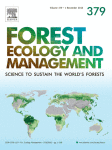Ver ítem
- xmlui.general.dspace_homeCentros e Institutos de InvestigaciónCIAP. Centro de Investigaciones AgropecuariasInstituto de Fisiología y Recursos Genéticos VegetalesArtículos científicosxmlui.ArtifactBrowser.ItemViewer.trail
- Inicio
- Centros e Institutos de Investigación
- CIAP. Centro de Investigaciones Agropecuarias
- Instituto de Fisiología y Recursos Genéticos Vegetales
- Artículos científicos
- Ver ítem
Nurse plants and seed provenance in the restoration of dry Chaco forests of central Argentina
Resumen
In degraded dry environments, a promising restoration strategy involves nurse plants and their microsites, which facilitate species recruitment. Different nurse plant species might provide different microclimatic and soil conditions under their canopy as well as diverse herbivory protection strategies. Seed provenance of target species is also relevant to restoration success. We evaluated the effectiveness of two native woody species (Parkinsonia praecox
[ver mas...]
In degraded dry environments, a promising restoration strategy involves nurse plants and their microsites, which facilitate species recruitment. Different nurse plant species might provide different microclimatic and soil conditions under their canopy as well as diverse herbivory protection strategies. Seed provenance of target species is also relevant to restoration success. We evaluated the effectiveness of two native woody species (Parkinsonia praecox and Larrea divaricata) as nurse plants for Prosopis flexuosa establishment to be used in restoration programs in semiarid Chaco forests of central Argentina. We conducted a field experiment in a degraded site to analyze microclimatic and soil characteristics under the canopy of the nurse species and in bare soil. In these microsites we planted 240 P. flexuosa saplings to evaluate their performance during two years, including local and non-local provenances. Both nurse species were safer sites for recruitment than bare soil, because under their canopies microclimatic characteristics were ameliorated and soil nutrient availability was increased, with the best sapling performance being under P. praecox crown. Of the total plants that survived (42%), most of them did so under the nurses (74%). Height of P. flexuosa saplings decreased regarding initial height, in the three microsites. Herbivory greatly limited sapling establishment success in bare soil; therefore, both nurses would have an important role in providing shelter. P. flexuosa performance was not influenced by provenance. Including P. praecox and L. divaricata as nurse plants in restoration strategies would promote the use of established vegetation in recovering the semi-arid Chaco forest.
[Cerrar]

Autor
Venier, P.;
Ferreras, A.E.;
Lopez Lauenstein, Diego;
Funes, G.;
Fuente
Forest Ecology and Management 529 : 120638 (February 2023)
Fecha
2023-02-01
Editorial
Elsevier
ISSN
0378-1127
1872-7042 (online)
1872-7042 (online)
Formato
pdf
Tipo de documento
artículo
Palabras Claves
Derechos de acceso
Restringido
 Excepto donde se diga explicitamente, este item se publica bajo la siguiente descripción: Creative Commons Attribution-NonCommercial-ShareAlike 2.5 Unported (CC BY-NC-SA 2.5)
Excepto donde se diga explicitamente, este item se publica bajo la siguiente descripción: Creative Commons Attribution-NonCommercial-ShareAlike 2.5 Unported (CC BY-NC-SA 2.5)

